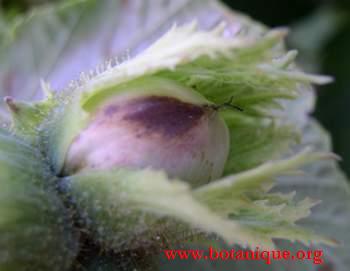Plants produce oxygen by photosynthesis. By this same mechanism, plants transform mineral carbon into organic carbon usable by animals. Plants are autotrophic (self nourishing: producers) contrasting with the heterotrophic animals (consuming other living things: consumers). The plants are thus a paramount element of any food chain. 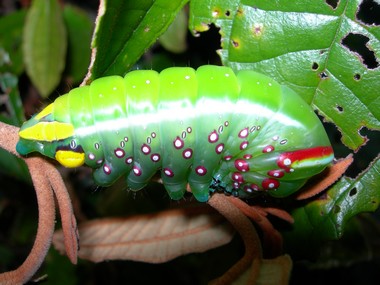 Plants allow many animal species to live: either as being their host, or as food. It is thus possible to design food chains without animals but there are none without plants. Plants also facilitate the penetration of water into the soil and limit the run-off of rainwater. They make it possible under more arid climates to fight desertification. Plants, thanks to their roots, stabilise soil. See: dune, stranding, defense and soil conservation, landscape restoration. Plants are also important for the fertilization of soils (humus).
Plants allow many animal species to live: either as being their host, or as food. It is thus possible to design food chains without animals but there are none without plants. Plants also facilitate the penetration of water into the soil and limit the run-off of rainwater. They make it possible under more arid climates to fight desertification. Plants, thanks to their roots, stabilise soil. See: dune, stranding, defense and soil conservation, landscape restoration. Plants are also important for the fertilization of soils (humus). 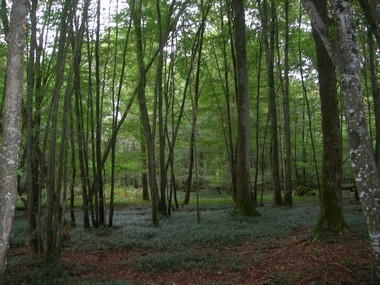 Plants are source of life for Mankind. For people, plants provide nourishment (food, condiment plants), protection (fuel wood, houses), amenity (furniture, materials), and medicine (medicinal plants). Crop plants are bred to maximise yield and are genetically rather uniform compared to wild relatives. Wild plants potentially offer the genes of resistance to the crop diseases. Relatively few plants have been exploited for medicines. The whole plant kingdom presents a potential reservoir of medicinal uses (substances, drugs…).
Plants are source of life for Mankind. For people, plants provide nourishment (food, condiment plants), protection (fuel wood, houses), amenity (furniture, materials), and medicine (medicinal plants). Crop plants are bred to maximise yield and are genetically rather uniform compared to wild relatives. Wild plants potentially offer the genes of resistance to the crop diseases. Relatively few plants have been exploited for medicines. The whole plant kingdom presents a potential reservoir of medicinal uses (substances, drugs…). 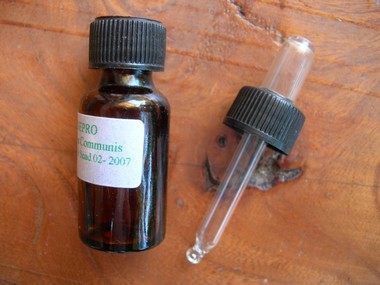 The vast genetic resources of the plant kingdom require conservation to protect biological diversity and secure the future of Mankind.
The vast genetic resources of the plant kingdom require conservation to protect biological diversity and secure the future of Mankind.
All posts by _
Development and conservation of an herbarium
Methods of development of an herbarium General Principles After their determination and their identification, the plants are dried under press before being fixed by adhesive without acid on paper without acid. The boards are then gathered by family by respecting a phylogenic classification. Technical Advises Drying The plants are dried in newsprint which is changed regularly until complete drying (except, the sheet directly in contact with the plant). When a batch of plants is thick, it is recommended to place some boards of rigid paperboard to avoid the deformation of the plants. Pressing. It is not necessary that the plants are crushed. The press can be simple. For example, press can be easily made up of 2 grids of refrigerator maintained tightened by straps or various masses distributed uniformly on the surface of a board. 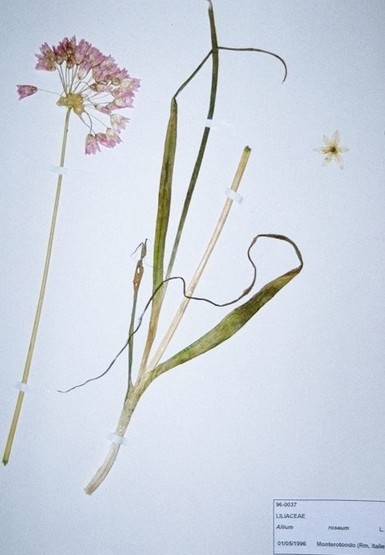 Quality of the exsiccata. To obtain samples of quality, drying must start as soon as possible after harvest. It is often noted that the plants lose their color after drying, except those containing sulphur (example naturally: garlic). To cure this disadvantage, the plants can be put in the presence of sulphur vapor just after harvest. The sulphur pastilles used for the sterilization of the wine barrels are appropriate. However, this method is tiresome. Cost of development the size of the boards is, commonly, of approximately 45 cm X 28 cm. However, these dimensions do not constitute an obligatory standard. Thus, Fournier indicates in the Four flora of France (1977, republication) that the herbarium itself can extremely well be made up on small size, for example on paper folios with machine (to be written). The boards which I use measure 32 cm X 29 cm and more than have an unit cost partial (except labour) 10 times lower than that calculated for the traditional boards, while respecting the schedule of conditions according to: paper and adhesive without acid, grammage raised, translucent paper (Bray and Al, 1997). The adhesive used to fix the dried plants can be paste distributed with a glue gun or rubber cement. This last product is sold under various marks but will always have the same chemical composition, containing natural rubber. Labelling The label or the data-processing recording of each board must comprise following information: – a reference number, – the family, the kind, the specie and the possible names infra-species.These indications must respect the nomenclature in force, – abbreviation of the name of the specific author, – the possible synonym, – the date of collection, – the place of collection. The use of a system of total positioning is recommended. It will make it possible to specify the latitude and longitude. For altitude, taking into account the error of the apparatus, it is preferable to use an altimeter, – the name of the collector and/or the name of the identifier, – the description of the biotope or phytosociological association (this last indication can, possibly, not be present on the label if it already exists in the data base computerized). In the case of the first labelling, the label is placed in bottom and on the right. If it is about a label bringing of the corrections, it must be placed in bottom and on the left.
Quality of the exsiccata. To obtain samples of quality, drying must start as soon as possible after harvest. It is often noted that the plants lose their color after drying, except those containing sulphur (example naturally: garlic). To cure this disadvantage, the plants can be put in the presence of sulphur vapor just after harvest. The sulphur pastilles used for the sterilization of the wine barrels are appropriate. However, this method is tiresome. Cost of development the size of the boards is, commonly, of approximately 45 cm X 28 cm. However, these dimensions do not constitute an obligatory standard. Thus, Fournier indicates in the Four flora of France (1977, republication) that the herbarium itself can extremely well be made up on small size, for example on paper folios with machine (to be written). The boards which I use measure 32 cm X 29 cm and more than have an unit cost partial (except labour) 10 times lower than that calculated for the traditional boards, while respecting the schedule of conditions according to: paper and adhesive without acid, grammage raised, translucent paper (Bray and Al, 1997). The adhesive used to fix the dried plants can be paste distributed with a glue gun or rubber cement. This last product is sold under various marks but will always have the same chemical composition, containing natural rubber. Labelling The label or the data-processing recording of each board must comprise following information: – a reference number, – the family, the kind, the specie and the possible names infra-species.These indications must respect the nomenclature in force, – abbreviation of the name of the specific author, – the possible synonym, – the date of collection, – the place of collection. The use of a system of total positioning is recommended. It will make it possible to specify the latitude and longitude. For altitude, taking into account the error of the apparatus, it is preferable to use an altimeter, – the name of the collector and/or the name of the identifier, – the description of the biotope or phytosociological association (this last indication can, possibly, not be present on the label if it already exists in the data base computerized). In the case of the first labelling, the label is placed in bottom and on the right. If it is about a label bringing of the corrections, it must be placed in bottom and on the left.
Definitions and utility of an herbarium.
Definitions and utility of an herbarium. The realization of an herbarium is always of topicality. An herbarium consists of dried plants, then fixed on paper boards without acid, protected by tracing paper and hard-bound shirts. The herbarium term indicates also the places where these dried plants are stored. 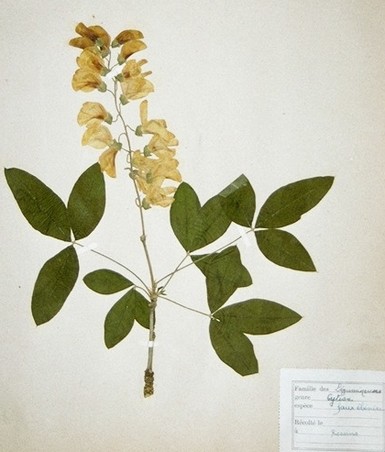 The most significant herbaria in the world, in a number of exsiccata (dried plants) are that of the national Natural history museum of natural history (8 million samples) then that of the royal Botanical garden of Kew. The herbaria can be private or institutional. Currently, undoubtedly because of budgetary restrictions, of many botanical gardens pose the problem of the utility of an herbarium. Utility of the herbaria There is a few years the constitution of an herbarium was obligatory in many courses school or university and all the botanical gardens had some. Currently, some discuss the need for an herbarium whereas its uses are numerous (Raynal-Castlings, 1994). The herbarium is a died vegetable collection. It presents an objectivity and an unquestionable reality compared to photographs. Thus, a dried plant can be given once again after hydration. The herbarium thus allows the potential validation of identifications carried out on the ground. The herbarium is an image at times given of the vegetation of various sites. It is thus possible to evaluate the evolution of the biodiversity. It makes it possible to establish cartographic inventories of the plants. The herbarium allows comparisons between different taxon and of the systematic studies. The boards of herbarium can be lent easily between various institutions of the whole world whereas it would be difficult to exchange material living or to organize forwardings on the ground. Some think, wrongly, that the herbarium can be replaced by images digitized on CD-Rom. Several reasons are opposed to this argument. On the one hand, the investment necessary and its maintenance (multi-media computer, numerical camera, memory) are often out of reach many botanical gardens. In addition, the many keys necessary to the identification of a plant should be replaced per as many photographs: the quantity of memory to be managed would become, in the current of the techniques, extremely difficult, and in all the cases, very expensive state. Moreover, certain floral aspects neglected at a time given thus not memorized can prove, in the future, paramount. In this case, only the possession of the dried plant will make it possible to validate the determination.
The most significant herbaria in the world, in a number of exsiccata (dried plants) are that of the national Natural history museum of natural history (8 million samples) then that of the royal Botanical garden of Kew. The herbaria can be private or institutional. Currently, undoubtedly because of budgetary restrictions, of many botanical gardens pose the problem of the utility of an herbarium. Utility of the herbaria There is a few years the constitution of an herbarium was obligatory in many courses school or university and all the botanical gardens had some. Currently, some discuss the need for an herbarium whereas its uses are numerous (Raynal-Castlings, 1994). The herbarium is a died vegetable collection. It presents an objectivity and an unquestionable reality compared to photographs. Thus, a dried plant can be given once again after hydration. The herbarium thus allows the potential validation of identifications carried out on the ground. The herbarium is an image at times given of the vegetation of various sites. It is thus possible to evaluate the evolution of the biodiversity. It makes it possible to establish cartographic inventories of the plants. The herbarium allows comparisons between different taxon and of the systematic studies. The boards of herbarium can be lent easily between various institutions of the whole world whereas it would be difficult to exchange material living or to organize forwardings on the ground. Some think, wrongly, that the herbarium can be replaced by images digitized on CD-Rom. Several reasons are opposed to this argument. On the one hand, the investment necessary and its maintenance (multi-media computer, numerical camera, memory) are often out of reach many botanical gardens. In addition, the many keys necessary to the identification of a plant should be replaced per as many photographs: the quantity of memory to be managed would become, in the current of the techniques, extremely difficult, and in all the cases, very expensive state. Moreover, certain floral aspects neglected at a time given thus not memorized can prove, in the future, paramount. In this case, only the possession of the dried plant will make it possible to validate the determination.
Axile or parietal placentation in fused carpels
The following pictures show the 2 main categories of placentation : – when placentation is axile, placentas link seeds and fruit axis : example of a tomato (Lycopersicon esculentum, Solanaceae), – when placentation is parietal, placentas link seeds and fruit wall : example of a kiwano (Cucumis metuliferus, Cucurbitaceae). 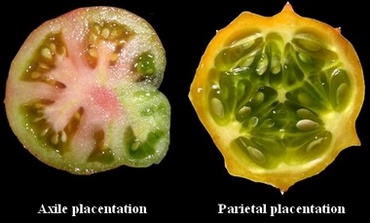 The following sketch explains the different evolution states from free carpels in an apocarpous gynaecium to fused carpels in a syncarpous gynaecium with axile or parietal placentations: – Axile placentation. Carpel sides are fused together in septa (plural of septum). Carpel margins are found on the axis of the composed ovary. Ovary is plurilocular. Placentas (conducting tissue for ovules) and ovules are located along the ovary axis: placentation is axile. – Parietal placentation. Carpels are fused by their margins and placentas develop along the composed ovary wall. Ovary is unilocular.
The following sketch explains the different evolution states from free carpels in an apocarpous gynaecium to fused carpels in a syncarpous gynaecium with axile or parietal placentations: – Axile placentation. Carpel sides are fused together in septa (plural of septum). Carpel margins are found on the axis of the composed ovary. Ovary is plurilocular. Placentas (conducting tissue for ovules) and ovules are located along the ovary axis: placentation is axile. – Parietal placentation. Carpels are fused by their margins and placentas develop along the composed ovary wall. Ovary is unilocular. 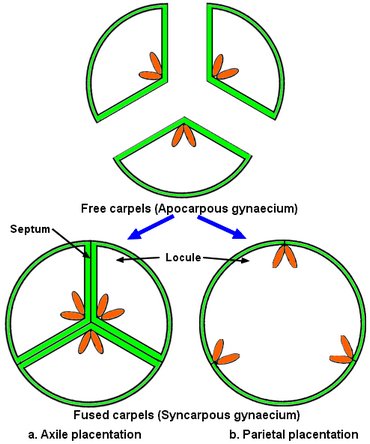
Xylem and phloem saps
Two sap categories can be found in a vascular plant: – a sap containing water and minerals taken from the soil by the roots. It is conducted by a tissue called xylem. The xylem sap mainly goes from the roots to the photosynthesis sites (usually leaves): it is often called ascending sap in French. The ascent of xylem sap depends on transpiration and water physical properties: the solar-powered bulk flow. – a sap containing water and solutes, such as amino acids or sugars, mainly sucrose created by photosynthesis. It is conducted by a tissue called phloem. The phloem sap mainly goes from the leaves to other parts of the plant, especially roots. It is often called descending sap in French but this definition doesn’t take into account translocation of phloem sap from reserve organs (tubers for example) to other parts of the plant. The translocation of phloem sap is powered by the difference of osmotic pressure between sugar sources (where sugars mainly sucrose are produced) and sugar sinks (where sugar are consumed): the mass flow hypothesis.

